Abstract
Preserving historical railway assets presents a complex systems challenge, in which uncertainties in material performance, structural degradation, and regulatory requirements directly impact long-term reliability and operational continuity. Traditional maintenance practices often limit the use of modern materials, introducing inefficiencies, increased lifecycle costs, and higher failure risk due to material ageing and environmental exposure. This study proposes a reliability-informed preservation framework that supports the integration of contemporary materials into historical railway infrastructure while accounting for legal, material, and procedural uncertainties. The framework is validated through two industrial case studies, each reflecting different regulatory and operational constraints. The first case demonstrates the successful substitution of timber with certified PVC cladding on a non-listed signal box, achieving improved durability, reduced maintenance intervals, and enhanced system reliability. The second case explores an unsuccessful attempt to replace decayed timber gables with aluminium, in which late-stage planning misalignment, underestimated risks, and uncertainty in approval outcomes led to a significant cost increase and reduced reliability regarding delivery. By systematically applying and evaluating the framework under real-world conditions, this research contributes to engineering asset management by introducing a structured method for mitigating regulatory and material uncertainties.
1. Introduction
The railway system of Great Britain has a long history, starting in the 18th century [1,2]. After over 300 years of development, its infrastructure asset portfolio and range have become substantial. The Historical Railways Estate (HRE) has a collection of over 3100 structures and assets that were once part of Britain’s rail network. More than 1450 items have survived from all periods of the railway’s history and are listed as being of architectural or historic interest—including over 380 station buildings, 639 viaducts and bridges, 65 tunnels, 67 signal boxes, four hotels, 40 memorials, gates, and clocks, and over 250 other buildings or structures [3,4], which contribute to social and economic development through transport and tourism [5,6].
Given the substantial size and age of the asset portfolio, managing and maintaining these historical assets pose significant challenges. The historical nature of many of these structures, combined with the lack of comprehensive records, operational restrictions, and preservation requirements for repairs and renewals, presents a complex scenario.
Academia and industry [7,8,9,10,11,12] have made some progress in maintaining historical assets. For instance, Borges (2020) introduced an indicator-based approach to assess railway heritage, highlighting systemic preservation challenges [13]. Regarding laws and regulations [14], the national planning policy framework, Section 12, defined over 1400 railway assets as listed buildings and structures. Nearly all modifications to them require some form of listed building and planning consent, as detailed in the Planning (Listed Buildings and Conservation Areas) Act 1990 [15]. In addition, the railway is the only industry with specific legislation protecting its heritage. The government has introduced the Railway Heritage Act [16] to enable historically significant artefacts and records operational within today’s railway industry to be ‘designated’—protected and saved for the nation so that future generations can understand the railway’s history in Britain. The industry also has various maintenance standards, such as NR/GN/CIV/100/05 [3]. They stipulate that short-term solutions or repairs and cosmetic changes likely to cause long-term damage, such as strengthening, signage, propping, and servicing installations, should be avoided according to the law and standards.
Nevertheless, real maintenance activities commonly contradict the law and standards [17,18]. For example, additional installations of modern monitoring systems such as CCTV can cause physical damage to the fabric of a building as well as produce a visual eyesore. NR/L3/CIV/023 Work Instruction [19] is another standard for the assessment of footbridges. As a result of the assessment standard, it denotes the need for immediate action as soon as a defect occurs, regardless of whether it is listed or not. However, the study conducted by Network Rail [20] found that all of the reviewed Level 2 assessments of underbridges demonstrated that the capacity calculated using Level 1 techniques from the standard can be significantly improved using a different standards analysis. Following current assessment standards, the analysis involves complex equations that are not always applied consistently and tend to deliver a low assessed capacity, leading to unnecessary, unsightly, and costly recommendations for strengthening works, contradicting planning laws and the NR/GN/CIV/100/05 standard. It is important to address these contradictions as early as possible. When high-quality heritage and design advice is received at the beginning of each project or repair, unexpected costs can be minimised, with a lower risk of lost time in consultations with local planning authorities or statutory national heritage bodies.
Some research studies have considered ageing materials in heritage structures [21,22,23]. Iron and steel were frequently used for stations and buildings, incorporating both types of materials with the addition of timber. However, unlike masonry, iron, steel structures, and wooden elements are more susceptible to corrosion and stress, which affects their longevity. The Railway Heritage Trust (RHT) [24] highlights that the materials’ extensive maintenance requirements and their associated structural and aesthetic deterioration pose significant issues for railway preservation today. However, only limited studies have been undertaken to address the replacement of unique or minor elements of original material construction using modern emerging materials such as polymers [25,26,27,28], fibre-reinforced polymer (FRP), and glass reinforced plastic (GRP) [29,30,31,32,33].
Baxter [24] focused on the history and maintenance requirements of the humble canopy daggerboard. The study investigated the use of FRP for station canopy fascia daggerboards. Timber daggerboard is a design element that serves the vital, practical function of carrying run-off rainwater away from the canopy structure and improving ventilation inside the canopy. Its ornamental potential was quickly recognised, and it can now be considered as one of the archetypal features of a traditional British railway station in the popular imagination. As a result, there are more than one thousand stations on the British rail network with canopy fasciae and daggerboards. The boards exposed to weathering result in the appearance of degradation over time. It can also lead to timber rotting and material failure, resulting in individual boards falling away, posing a health and safety risk to both trains and the public. Maintenance work on timber daggerboards requires tracking ‘possessions’, impacting the infrastructure availability and asset reliability, incurring considerable costs, and increasing the health and safety risks to which staff are exposed, both from working at heights and from electrocution from overhead contact systems. However, such work is frequently deferred or cancelled due to cost and time implications, resulting in continued deterioration.
Another important consideration is the authenticity or originality of the construction material of the historic asset. Timber daggerboards have an estimated lifespan of thirty years. According to the standard, repair and maintenance are required every ten to twelve years, but it is unlikely that any nineteenth-century timber can survive in a valance canopy.
This highlights another challenge when managing historical assets. Due to the age, longevity, and period in which many historical assets were designed, constructed, or manufactured, full and comprehensive asset data are not always available. Renewals or previous repairs of minor elements are frequently not recorded or available. This leads to difficulties in predicting how structures and assets with many existing major structural defects will behave, even under ideal conditions, in which monitoring and damage prediction remain inherently challenging [34,35,36]. Network Rail [20] stated that modelling historic assets is exceptionally complex and prone to inaccuracy, as a combination of corrosion, weathering, and previous poor-quality materials or repairs compromises materials. Mcmahon, Zhang, and Dwight [37] identified the main categories of missing data types in rail systems, applicable to the historical assets found at Network Rail (NR), such as from the commissioning of a system and from maintaining and operating an asset. The research proposed, analysed, and discussed AI-led advanced models and algorithms applied to recover the missed data. This is a good approach and an in-depth study in filling performance and data gaps for historical assets, although it has not been tested for specific asset types, materials, or ages. Similarly, Adams et al. [38] understood the impact of weather events on asset performance and the failure of the historic sea wall at Dawlish. They produced a multi-hazard risk model with cascading FPW to remove gaps in the historical data.
The existing maintenance and asset management literature primarily focuses on isolated asset types or failure mechanisms, often neglecting the broader system-level considerations associated with historical infrastructure. Recommendations are typically presented as linear proposals for material strengthening or replacement, with limited attention to the regulatory uncertainties and planning processes specific to heritage assets. Moreover, the potential reliability benefits and lifecycle cost reductions associated with the integration of contemporary materials and design techniques remain underexplored.
This study addresses this gap by evaluating the relationship between material innovation, lifecycle cost performance, and the uncertainty involved in securing planning approvals for changes to historically significant railway assets. A reliability-oriented theoretical framework is developed to support the strategic preservation of historical railway infrastructure, accounting for material, regulatory, and procedural uncertainties in a structured and scalable manner.
2. Methodology
The methodology was staged into three parts to understand further the challenges faced when preserving heritage assets, which were highlighted in the literature review, and to develop a framework for modern preservation in the future.
As illustrated in Figure 1, a targeted survey was initially sent to various subject matter experts and practitioners in the railway industry. The feedback received helped develop the theoretical framework. It also led to a more targeted set of personal interviews. Then, the theoretical framework was developed and applied to two industrial case studies via construction projects delivered by Network Rail UK. The effectiveness of the framework was investigated via personal interviews.
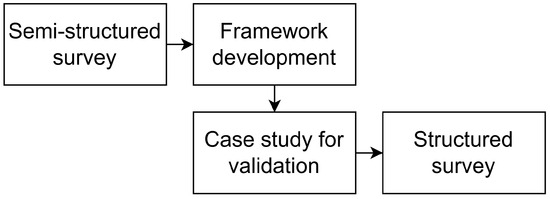
Figure 1.
Methodology flow chart.
2.1. Semi-Structured Survey
Given the impracticality of interviewing all employees at NR, a semi-structured targeted survey was deemed the most effective approach for ensuring a representative sample while minimising bias. This method was selected to identify existing gaps in real industrial applications and support the development of a framework to address contemporary challenges in historical asset preservation. The survey was distributed through Microsoft Forms (Microsoft 365 Version 2405), and the responses were analysed using Excel (Microsoft 365 Version 2405).
Ten participants were chosen from key departments relevant to this study, including asset management, the technical authority, town planning for listed consent, and maintenance and project delivery teams responsible for design and implementation. This multidisciplinary approach ensured that the perspectives captured reflected historical asset preservation’s practical, technical, and regulatory aspects.
Although this selection does not encompass all roles within NR, it was expected to enhance the sample’s representativeness and the findings’ reliability. Given the diverse nature of NR’s asset portfolio and the regulatory frameworks governing historical structures, comparisons with local planning authorities (LPAs) were also considered valuable for identifying procedural inconsistencies and best practices in historical asset management.
2.2. Framework Development
Based on the survey results, a theoretical framework has been developed to establish a strategic approach for repairing and maintaining historical assets. The framework facilitates continuous improvement, ensuring that buildings and structures retain their functional and historical significance without becoming static heritage artefacts.
Given the operational demands of historical railway assets, adaptation is essential for long-term viability. This framework supports sustainable preservation by balancing historical integrity with contemporary performance enhancements. It provides a structured methodology for implementing changes that uphold the asset’s architectural and historical value while optimising performance, standardising data collection, and reducing uncertainties in the listed consent process.
2.3. Case Study Validation
The proposed theoretical framework was applied to real-world asset management projects within NR. Two case studies implemented the framework to assess cost/benefit outcomes and identify inconsistencies in the listed consent process across different local authorities.
3. Initial Survey Results and Discussion
A semi-structured questionnaire was developed based on gaps identified in the literature. To process the collected data, responses were categorised into simplified groups, making it easier to interpret the experiences and challenges faced by participants in the field. The results were quantified in percentage terms to identify trends and patterns.
3.1. Common Causes of Asset Failure and Implications for Material Substitution
Firstly, respondents were asked about the leading causes of asset failure affecting listed and historical structures within NR. The responses were analysed and categorised into overarching failure mechanisms, as visualised in Figure 2.
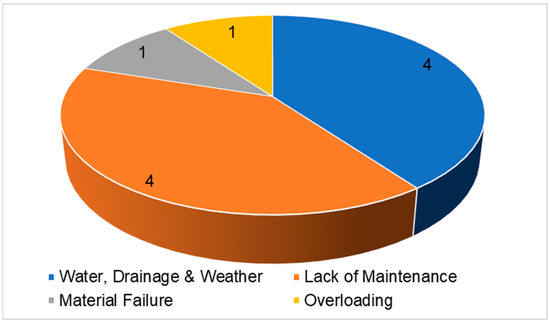
Figure 2.
Participants’ response to the survey to establish the leading type of asset failure of historical assets.
The results indicate that the most significant contributors to asset deterioration are insufficient and irregular maintenance throughout the asset’s lifecycle and damage caused by water ingress and weathering, both of which frequently lead to structural failure.
These findings align with the literature [39], highlighting historical assets’ vulnerability to degradation processes such as corrosion and erosion due to the materials used in their original construction. Additionally, inadequate maintenance of drainage systems and protective coatings was identified as a key factor, supporting previous studies, such as one that suggested replacing station canopy daggerboards of timber with FRP to mitigate weather-related deterioration [24].
Comparing these responses with participants’ views on material changes, there is a clear correlation between the elements most affected by weathering, degradation, and failure and their architectural and aesthetic significance. This shows the importance of preserving these components to ensure both structural integrity and compliance with legal protection requirements.
The RHT commissioned a report on using fibre-reinforced plastic (FRP) to replace station fascia daggerboards, which has significant advantages over traditional wooden elements prone to material failure. Building on this, the survey included a question seeking suggestions on which elements of a listed asset would benefit from replacement with contemporary materials.
3.2. Identification of Asset Components Suitable for Material Substitution
The responses in Figure 3 identify mainly two elements, glazing systems and timber elements, that benefit the most. They have several key features that experience rapid or frequent degradation, primarily due to the inherent properties of their original materials. This deterioration affects asset performance and leads to increased maintenance frequency and higher long-term costs. This higher maintenance requirement can be mitigated if material and manufacturing processes are changed.
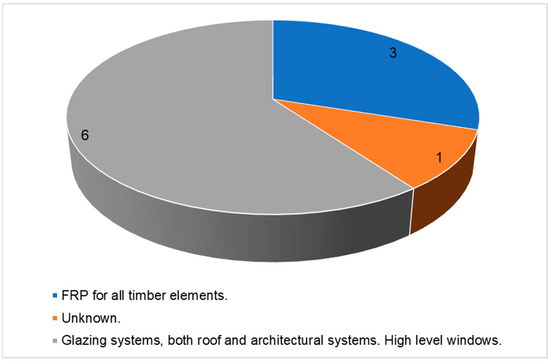
Figure 3.
Participant response to the survey to help establish which elements of an asset could benefit most from a contemporary change in material or manufacturing process.
3.3. Industry Awareness and Knowledge Gaps
Following this question, the participants were asked whether they perceived a lack of awareness within the industry regarding contemporary techniques and emerging technologies. The responses included six “yes” responses, three “no” responses, and one response indicating “unknown”. Combining the responses from Figure 3 indicates that most of the participants agreed on which elements of historical assets would benefit from a material change to improve their preservation. However, there was limited awareness of the specific contemporary materials and techniques available or previously implemented in similar contexts. This is a critical gap for which further research and industry focus could lead to measurable improvements in cost efficiency, maintenance time, and long-term asset sustainability.
A broader set of questions was included to explore potential correlations between industry competencies, the lack of comprehensive knowledge regarding contemporary materials and manufacturing techniques, and the absence of accessible records on previous successful interventions for historical assets. The absence of such information may negatively impact the planning approval and consent process.
Additional questions were posed to understand why planning applications proposing changes to historical assets are frequently rejected. Participants were asked whether they perceived a connection between proposed modifications and planning rejections. The survey responses are illustrated in Figure 4. Many of the respondents (four out of ten) frequently perceive a relationship between proposed material or technological changes and the rejection of planning applications. This suggests that stakeholders experience significant challenges in gaining approval for modifications to historic assets.
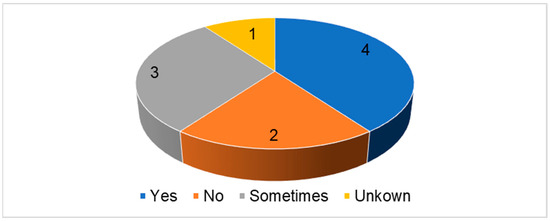
Figure 4.
Participants’ response to the survey to establish relationships between proposed changes and the success of planning applications.
Additionally, three respondents selected “Sometimes”, indicating that while this issue is not always a barrier, it occurs often enough to be a concern. The two “No” responses suggest that, in some cases, proposed changes do not necessarily lead to rejection, possibly depending on the nature of the modification or the local authority involved. These responses reinforce the challenges of integrating contemporary materials into historical asset preservation. The results suggest that planning authorities may have varying acceptance levels for technological and material updates.
The pie chart in Figure 5 presents responses to the following question: ‘Do you feel that due to a gap in the Network Rail processes or design documentation, there is a need to duplicate activity when making a planning application to the local authority when working on a listed asset?’

Figure 5.
Participant response to the survey to establish any gaps in NR processes or documentation and whether activity is duplicated as a result.
The results indicate that the duplication of efforts in regards to planning applications for listed assets is a recurring issue, though not universally experienced. Eight respondents stated that duplication occurs in some cases, suggesting that while the planning and approval process does not always require redundant work, inconsistencies in Network Rail’s internal processes or documentation gaps can lead to unnecessary repetition.
A smaller portion of respondents indicated that duplication is a frequent or systematic issue, implying that inefficiencies exist in aligning Network Rail’s documentation with local authority requirements. This may be due to differences in design submission formats, planning application procedures, or coordination between departments. The findings suggest that a more streamlined and standardised approach to planning applications is needed to minimise redundant work. Improving the coordination between the rail asset management body and local authorities could help ensure the design documentation meets planning expectations. Further investigation into specific cases in which duplication is required may help identify common factors contributing to inefficiencies in the process.
3.4. Coordination Barriers and Documentation Misalignment in the Planning Process
The misalignment is further reflected in the specific challenges identified by respondents in Table 1. Several key factors contribute to the duplication of work when obtaining design approval from the railway infrastructure authority and planning consent from local authorities. These issues primarily stem from inconsistencies in documentation requirements, differing expectations between regulatory bodies, and a lack of coordination during the approval process.

Table 1.
Participants’ responses to the survey to provide reasons for why duplication of work has been performed by industry practitioners, offering initial insights into what needs to be addressed.
One recurring theme is the misalignment between the design documentation used within the railway sector and the expectations of LPAs. Several respondents noted that planning authorities often do not accept documents in the standard format used by the infrastructure management organisation, leading to additional submissions or modifications. Similarly, the level of detail required in planning applications varies, with some submissions requiring highly detailed drawings while others may need more generalised design information. This discrepancy leads to inefficiencies and additional work to tailor submissions based on differing requirements.
Another challenge identified is the iterative nature of the planning process, and approvals are often contingent on multiple revisions. One respondent noted that planning authorities sometimes fail to provide clear guidelines up front, resulting in multiple design iterations—sometimes up to five or six revisions—before reaching an acceptable solution. This lack of clear direction increases the time and effort required for approvals, adding unnecessary complexity to the process.
A lack of understanding of heritage-specific issues within the supply chain was also cited as contributing to additional work. If those involved in the design and approval process lack sufficient knowledge of historical asset preservation, applications may fail to address key heritage considerations, leading to further reworks. This is compounded by the fact that approvals from the railway authority do not always align with those of the LPAs, creating additional layers of consent that must be navigated.
Some respondents also pointed to the complexity of the multi-layered approval process, in which additional stakeholders, such as design review panels and heritage trusts, must provide comments or grant their approval before planning consent is granted. Sometimes, these comments are subjective or conflicting, further complicating the approval process and requiring additional iterations to satisfy all involved parties.
Finally, the level of early engagement between asset management teams and town planning teams plays a crucial role in minimising duplication. One response emphasised that the extent of early collaboration in the remitting and scoping phase can significantly impact the efficiency of the approval process. Insufficient engagement at the outset may result in misalignment between design proposals and planning requirements, leading to delays and additional revisions.
Overall, the responses suggest that improving coordination between regulatory bodies, standardising documentation requirements, and ensuring early stakeholder engagement could help reduce duplication and inefficiencies in the planning approval process for historical railway assets.
4. Development of a Preservation Framework for Historical Railway Assets
A theoretical framework has been developed, as shown in Figure 6, to establish a structured strategy for repairing and maintaining historical assets. The framework consists of five iterative stages—Empathise, Define, Ideate, Prototype, and Test—which together form a continuous improvement cycle. It is designed to facilitate managed change, balancing preserving historically significant features with the practical requirements of continued use.
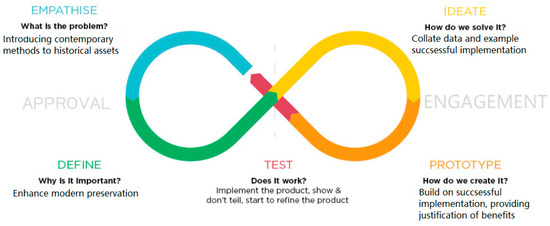
Figure 6.
A framework for enhancing preservation through innovation.
Given that structures within the operational railway network must adapt to remain viable, the framework aims to ensure that any proposed modifications retain key historical characteristics while simultaneously enhancing asset performance and data collection processes. This approach reduces uncertainties in the listed consent approval process by improving the accuracy of recorded information.
4.1. Empathise
The preservation of historical assets often lacks a standardised process or clear guidance, leading to subjectivity and conflicting opinions regarding proposed changes. This results in multiple layers of approvals, adding complexity to the consent process. The absence of documented evidence supporting the benefits of contemporary methods can further restrict their adoption in maintaining and conserving historical assets.
4.2. Define
When interventions are required for a historical asset, it is essential to review prior applications of contemporary methods in comparable scenarios and explore existing materials and techniques used in other industries that could enhance modern preservation practices and extend the asset’s lifecycle performance [40].
Engagement with independent third-party experts at an early stage of the design and planning process can help establish a strong foundation for project proposals. By incorporating lifecycle benefits into the initial submission to LPAs, it becomes possible to address uncertainties and the lack of supporting evidence, ultimately improving approval rates for contemporary material applications.
4.3. Ideate
It is recommended that the railway infrastructure authority expand its existing property and land database to document historical assets systematically. This database should incorporate records of successfully completed preservation projects, ensuring that relevant data are linked to similar assets. By coding these records effectively, the system could provide a comprehensive reference for projects that have successfully integrated material changes, facilitating informed decision making in future planning and conservation efforts.
4.4. Prototype
As design approvals required under railway infrastructure standards do not always align with the approval documents mandated by LPAs, discrepancies often arise due to differences in documentation formats or a lack of mutual understanding. To address this, the design submission process should be customised for each historical asset, integrating the proposed material changes within a format that aligns with LPAs’ expectations. This adaptation could reduce design and documentation redundancies while increasing approval rates for contemporary interventions.
To further reduce planning revisions, the framework proposes a repeatable strategy that includes early engagement with planning officers during the scoping phase and the use of previously approved cases as reference. By anticipating approval expectations and tailoring submissions accordingly, it is possible to streamline the approval process and minimise the likelihood of multiple design iterations.
4.5. Test
As projects incorporating contemporary materials are successfully delivered, these records should be systematically documented within the historical asset database. Accumulating proven case studies will help eliminate subjective and conflicting opinions regarding material changes by providing a repository of accepted products with quantifiable benefits in modern preservation.
The framework is designed to function as a continuous improvement cycle, in which each completed project contributes to refining material performance strategies for historical assets. By maintaining a loop of iterative enhancement, this approach supports the progressive integration of contemporary preservation methods, ensuring both regulatory acceptance and improved long-term asset resilience. It supports enterprise-level decisions by improving the reliability of material planning and reducing uncertainty in the maintenance of historically significant assets.
5. Case Studies
Two case studies were examined to evaluate the proposed framework’s applicability.
5.1. Case Study 1: Willesden Carr South Signal Box Renovation
A signal box awaiting refurbishment was identified, with an existing repair design dating back to 2014. The structure exhibited extensive rot in its primary timber structural members and side panelling, as documented in Figure 7 and Figure 8. The observed deterioration is consistent with the research findings on common asset failure mechanisms, particularly the impact of insufficient maintenance and material degradation over time.
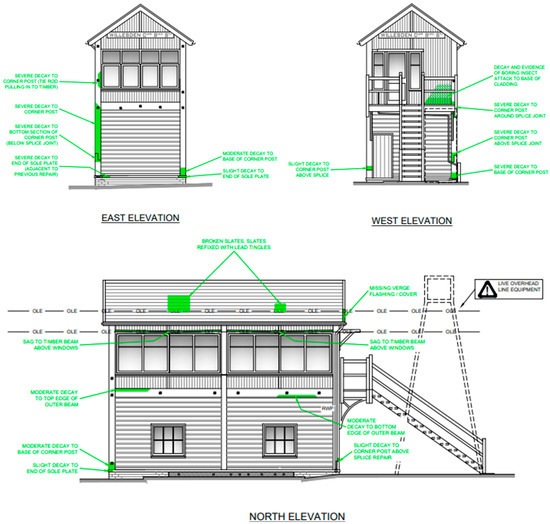
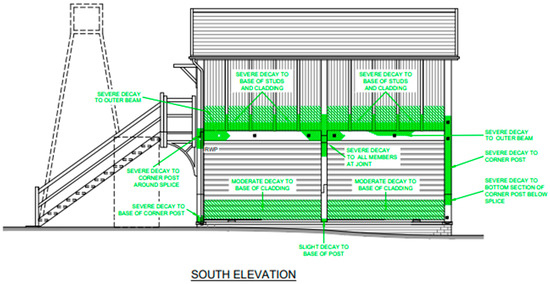
Figure 7.
Drawings of details and extent of failed material elements of the signal box.
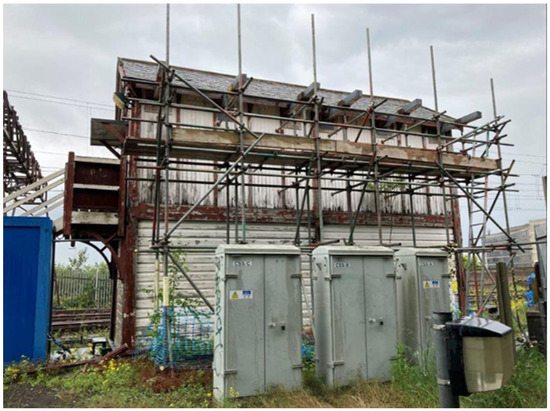
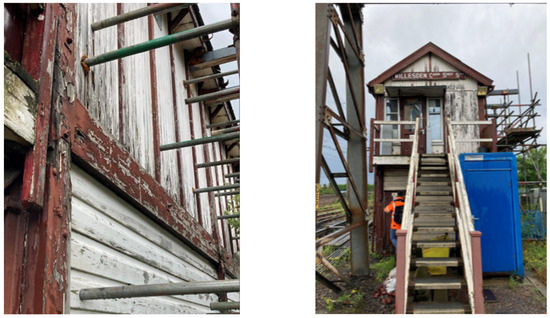
Figure 8.
Photograph of the inherited state of the signal box asset with prominent material decay and failure and the temporary support scaffolding.
A low-load assessment was conducted and confirmed that short-term, inadequately designed temporary works consisting of scaffolding had been previously implemented to maintain the asset’s operational status. This approach, frequently employed as a reactive solution, often results in further degradation and unintended damage to historical railway assets.
The existing repair design requires the following:
- The existing paint finish should be stripped throughout. Renovate or renew all defective timbers, including (but not limited to) the replacement of the areas indicated in the drawings. All renewals to the main frame members should be hardwood with a ‘like for like’ section size. Replace main timber members and infill framing. Prepare and paint all existing and new timber.
- Remove existing cladding. Renovate the timber structure (see item 1.3). Reclad on a like-for-like basis. North, east, and west elevation: Prepare all cladding for redecoration. Renovate/renew any defective timbers like-for-like (including the replacement of an area of cladding affected by boring insects at an elevation of W above the landing). Paint all existing and new timber.
This case study provided an opportunity to apply the proposed framework to an industrial project in a live railway asset environment. The wider construction industry offers a broad range of contemporary building materials, many of which have the potential to enhance asset management within the rail sector.
By applying the framework, a material change could be implemented without full local LPA approval. A review of the product acceptance standard confirmed that building materials were outside the scope of this document. Following this review, a reassessment of the 2014 design was initiated, incorporating wood-grain-effect PVC cladding as an alternative to traditional timber. As a commercial off-the-shelf product, the PVC cladding met all necessary British Standards certification and, through an inquiry with the original equipment manufacturer (OEM), could be customised to match the original RAL colour scheme of the signal box. The use of substitute materials such as PVC in heritage contexts is increasingly supported in international conservation practice [41,42,43]. This aligns not only with the findings of the Railway Heritage Trust [24] but also with international preservation guidance, such as that issued by the U.S. National Park Service (2023) [44], which supports the use of substitute materials in historic buildings when appropriately matched. The revised designs for replacing the previous wooden cladding with PVC cladding like-for-like and implementing the new material on site are illustrated in Figure 9.
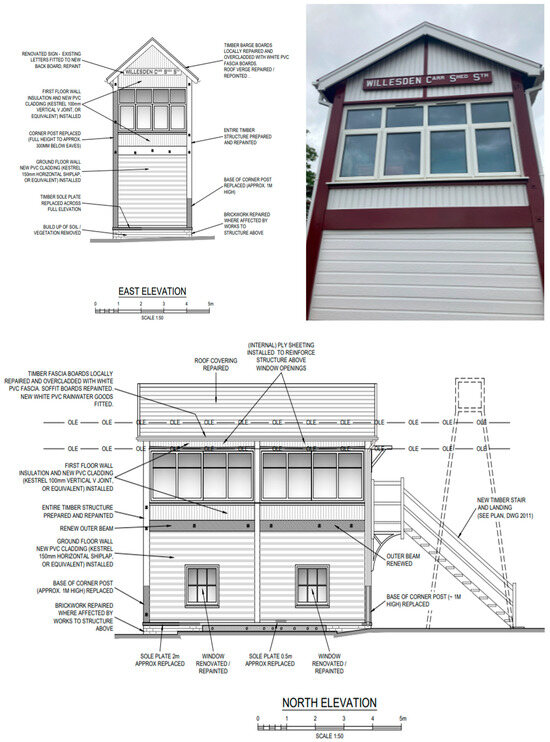
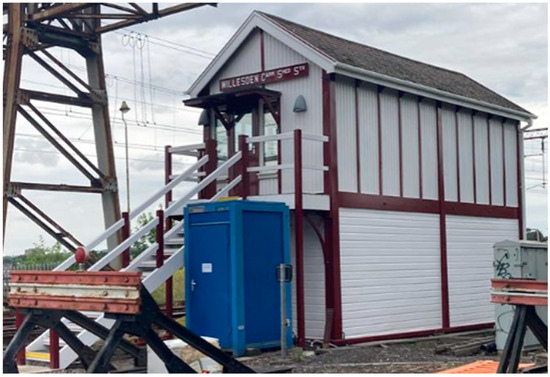
Figure 9.
Drawings of approved repairs for the signal box and on-site application of the new cladding system.
In contrast, PVC cladding offered significant advantages in both material consistency and installation efficiency, as illustrated in Table 2. Unlike timber, it did not require seasonal restrictions for painting, as painting timber can only be undertaken in specific weather conditions. This requirement extended the overall installation timeline, adding to project costs. The adoption of PVC cladding eliminated these constraints, streamlining the installation process and contributing to long-term cost savings in both maintenance and material performance.

Table 2.
Cost comparison of the 2014 and 2024 designs.
The material change also contributes to a substantial reduction in ongoing maintenance costs for the asset. According to the OEM’s paint system requirements, shiplap-treated timber cladding requires the stripping and reapplication of protective coatings every 15 years. However, due to budgetary constraints, there is no guarantee that these maintenance cycles are carried out within the specified timeframe. As a result, had timber been used, the signal box could have deteriorated once again, leading to the same state of disrepair.
In contrast, the PVC cladding provides a 60-year maintenance-free guarantee, eliminating the need for four costly and labour-intensive maintenance cycles over the same period. This ensures the long-term preservation and continued operation of the asset while significantly reducing lifecycle costs.
The final outcome was aesthetically consistent with the historical asset, successfully preserving its significant features, as demonstrated in Figure 9. The project also facilitated the removal of temporary structural supports, effectively extending the operational lifespan of the asset by 60 years. Following the completion of the works, the RHT was contacted, and the project has been accepted as a candidate for the National Heritage Awards.
In alignment with the proposed framework, the completed project documentation, product data sheets, and design details can now be incorporated into NR’s property and land database. This will serve as a reference catalogue of successfully executed material changes, enabling data integration for similar assets. By establishing a record of tangible benefits, this resource will support future proposals for material substitutions, particularly for listed assets, reducing subjective objections to contemporary materials and reinforcing the rationale for selecting alternatives over traditional materials.
5.2. Case Study 2: Stoke-on-Trent Station Gable End Replacement
Another case was initiated in March 2020 in response to the deterioration of two gable ends at Stoke-on-Trent Station as shown in Figure 10, which posed a significant safety risk to passengers and train operations. Due to the structural instability, the issue was escalated to the project team, who conducted an initial cost forecast. The estimated budget was set at three million GBP, primarily based on a comparable project previously undertaken at Preston Station. However, this estimate was largely analogous, relying on similarities in scope rather than a detailed site-specific assessment.
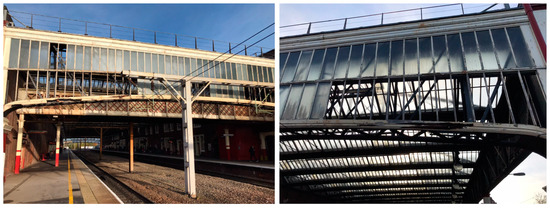
Figure 10.
Condition of Stoke-on-Trent station gable ends before commencement of the replacement.
One of the significant challenges faced in this case was the discharge of Listed Building Consent (LBC). During the design development phase, it was initially assumed that an aluminium frame would be an acceptable solution, as it had been approved in a similar project. However, discussions with the planning officer confirmed that only a like-for-like timber replacement would be permitted, and the proposal to use aluminium would be rejected. Duguid et al. documented similar regulatory challenges in the Ordsall Chord project [45].
The asset engineer explored various softwood alternatives, but Accoya® was ultimately selected to maximise design life, as shown in Figure 11. Accoya® is an engineered timber, for which pine trees are harvested at maturity (approximately 30 years old) and subjected to an acetylation process using acetic acid. This modification enhances the dimensional stability and durability of the wood [46].
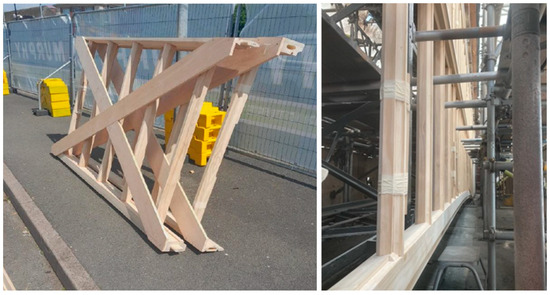
Figure 11.
The sections of the Accoya® frame and the new wood frame under construction.
The procurement of Accoya® contributed approximately one million GBP to the total project cost. Had alternative materials been accepted by the planning officer, significant cost savings could have been achieved. Additionally, the requirement for a like-for-like timber replacement resulted in a two-year delay as the design underwent an extended approval process.
Beyond the material selection challenge, the project also encountered difficulties in terms of the construction methodology. The original plan proposed lifting the wooden frame in one piece through a piecemeal approach. However, this method proved to be infeasible due to site constraints, including overhead line equipment (OLE) and limited headroom, which prevented the supplier from executing this approach as a cost-saving measure. These constraints necessitated an alternative construction strategy, further complicating project execution.
The challenges associated with the material change, design delays and modifications, and the constructability of a single wooden span over an operational railway have resulted in significant cost implications, as detailed in Table 3. Beyond the initial financial impact, the long-term maintenance obligations of the wooden frame must also be considered.

Table 3.
Project cost profile throughout the project from its conception to its current milestone.
The timber structure requires repainting every 15 years, posing the same logistical and operational challenges as the original installation, particularly due to the complexities of working over a live railway track. Had aluminium been approved, these maintenance interventions could have been avoided for 40 years, reducing disruptions, costs, and long-term risks while ensuring greater asset longevity.
In summary, the case study review and interviews with the project team led us to conclude that alternative procurement and town planning strategies could have mitigated many of the challenges encountered. It was further estimated that an approved final cost (AFC) of approximately six million GBP could have been achievable with a different approach, highlighting the potential for cost efficiencies through improved material selection, planning engagement, and procurement processes.
5.3. Reflections on Material Selection and Planning Challenges in Asset Conservation
5.3.1. Regulatory Challenges in Historical Asset Preservation
Renewal and repair work on historical assets require separate legal consent, particularly when modifications reach a certain degree of change. However, the term “specified degree” remains subjective, with no clear regulatory framework defining what alterations are permissible on a case-by-case basis. Approval from local planning authorities (LPAs) is essential for any modification. Still, the planning system is structured to present multiple barriers to change, affecting project costs, deliverability, sustainability, and innovation.
A key issue in the preservation of historical assets is the prevailing focus on ensuring that alterations remain “in keeping” with the existing architectural character of an area. While this principle protects historical integrity, it has negatively impacted material innovation and design advancements for over 300 years. The challenges identified in this study align with survey participants’ experiences managing Network Rail’s historical assets, in which restrictions on material choices often hinder the adoption of modern, more durable solutions.
5.3.2. Potential of Contemporary Materials in Historical Preservation
Despite these challenges, the research findings demonstrate promising initial results in adopting contemporary materials to enhance historical asset performance. The case studies indicate that it is possible to preserve aesthetic and significant historical features while simultaneously improving total lifecycle costs and aligning with both legal requirements and governmental sustainability policies.
5.3.3. Improving Technical Communication for Material Substitutions
One of the key challenges in modern asset preservation is the complexity of communicating engineering benefits to decision makers. The case study findings indicate that those responsible for granting approvals are often not engineers, leading to potential misinterpretations of technical data. Overly detailed design drawings and empirical performance data may fail to convey the practical benefits of material substitutions in a way that aligns with preservation objectives and continued asset functionality.
The study suggests that documentation similar to that in FRP daggerboard research [24] could effectively demonstrate the viability of contemporary materials in asset renewal. Reports endorsed by respected professional organisations can provide the necessary justification for material substitutions, increasing the likelihood of obtaining LPA consent.
5.3.4. Case Study 1: A Positive Outcome for Material Innovation
The validation of the framework through Case Study 1 yielded a positive outcome. The signal box in this case had the advantage of not being a listed asset, although its historical and operational significance suggests a high probability of future listing. This status enabled a simplified approval process, allowing the introduction of contemporary materials without the additional challenges of obtaining LPA consent.
The use of PVC cladding, a widely recognised commercial off-the-shelf product in the construction industry, provided a practical alternative to traditional timber. This material meets all relevant product performance, assurance, and accreditation requirements, ensuring compliance with building regulations. Integrating approved materials from other industries into railway asset renewal, in line with Network Rail’s design standards, resulted in improved asset performance and extended preservation through modern techniques.
By applying the framework, the successful implementation of PVC cladding provides a data-driven case for similar applications in the future. The recorded benefits can now serve as a reference for other listed assets requiring renewal, improving the likelihood of LPA approval by reducing uncertainties and offering evidence-based justifications for material changes.
5.3.5. Case Study 2: A Missed Opportunity for Modernisation
The framework application in Case Study 2 yielded less positive results, with the project facing significant setbacks due to incorrect assumptions and overconfidence in prior planning decisions. The unverified expectation that an aluminium alternative would be permitted—based on its approval for a similar project at Preston Station—was a critical misjudgement. This oversight stemmed from a failure to properly define the benefits of the proposed material change and an inability to present clear, substantiated data from the Preston project to the planning officers. As a result, the project faced underestimated costs and an overly optimistic delivery forecast.
Additionally, delayed engagement with town planners led to major modifications to the original proposal, as the LPA only approved a like-for-like material substitution. The selection of engineered modified timber aligned with the preservation requirements but significantly increased both implementation costs and future maintenance demands. These maintenance obligations introduce additional financial and operational burdens, particularly due to the challenges of working over an active railway network. The consequence of these constraints is that the gables will likely deteriorate more rapidly than anticipated, ultimately reducing the asset’s lifecycle efficiency.
While some minor positives can be drawn from introducing modified timber and a high standard of craftsmanship, the overall financial and logistical impact has been detrimental. The high costs and project delays have strained the budget, diverting resources from other necessary maintenance projects. This, in turn, increases the risk of accelerated deterioration in other assets, highlighting a missed opportunity for modernisation.
5.3.6. Key Comparative Findings from the Case Studies
A notable trend identified through comparing case studies is the financial and operational advantages of eliminating the need for applied coatings. When a contemporary material can match the appearance of the original construction while delivering superior performance, the total lifecycle costs are significantly reduced.
Many protective coatings are labour-intensive, with a shorter lifespan than the materials they protect. Their effectiveness is entirely dependent on their frequent reapplication and strict maintenance schedules. Failure to undertake these maintenance tasks results in not only aesthetic deterioration but also material degradation, leading to more frequent and costly repairs.
This research demonstrates that significant long-term cost savings can be achieved by replacing traditional materials requiring additional coatings with modern alternatives that inherently meet colour and aesthetic requirements. Similar benefits have been documented in the structural engineering literature, in which CFRP and GFRP have been shown to significantly enhance the flexural strength and stiffness of aged timber elements, indicating the broader applicability of fibre-reinforced materials in asset renewal contexts [47,48].
6. Conclusions
The presented work demonstrates that applying modern preservation techniques within a structured, reliability-oriented framework can significantly enhance the longevity, performance, and cost efficiency of historical railway assets. The proposed framework provides a practical approach to managing material substitution under regulatory and system constraints, enabling the introduction of contemporary methods while maintaining historical and functional integrity.
The research also highlights critical communication barriers in the planning approval process. Many decision makers involved in authorising changes to heritage infrastructure lack engineering backgrounds, which introduces subjective uncertainties into approval outcomes. To address this, the study advocates for a data-driven, system-level strategy, including the development of a national asset renewal database to offer quantifiable evidence supporting the reliability and regulatory acceptance of contemporary materials.
Through the analysis of two industrial case studies, the study reveals both the potential benefits and limitations of integrating modern materials into railway infrastructure. Case Study 1 demonstrates how the successful application of PVC cladding, supported by reliable performance data, can reduce lifecycle uncertainty and improve long-term asset reliability. In contrast, Case Study 2 highlights how delayed planning engagement and unvalidated assumptions regarding material approvals can lead to cost overruns, extended delays, and reduced delivery reliability.
Future research will aim to expand the empirical scope of this study by examining a broader range of historical asset types and contemporary material applications. Further case-based validations of successful modern material integration across various heritage contexts will also help strengthen the practical application of the framework.
Author Contributions
Conceptualization, T.W.; methodology, T.W.; software, T.W.; validation, T.W.; formal analysis, T.W.; investigation, T.W.; resources, T.W.; data curation, T.W.; writing—original draft preparation, T.W. and F.H.; writing—review and editing, F.H. and M.K.; visualization, T.W. and F.H.; supervision, M.K.; project administration, M.K.; funding acquisition, M.K. All authors have read and agreed to the published version of the manuscript.
Funding
This research received no external funding.
Institutional Review Board Statement
Not applicable.
Informed Consent Statement
Not applicable.
Data Availability Statement
The original contributions presented in this study are included in the article. Further inquiries can be directed to the corresponding author.
Conflicts of Interest
Author Thomas Wailes was employed by the company Network Rail. The remaining authors declare that the research was conducted in the absence of any commercial or financial relationships that could be construed as a potential conflict of interest.
References
- Casson, M. The World’s First Railway System; OUP: Oxford, UK, 2009. [Google Scholar]
- Gunn, S. The History of Transport Systems in the UK; Government Office for Science Foresight: London, UK, 2018. [Google Scholar]
- Network Rail. Heritage: Care and Development; Design Manual NR/GN/CIV/100/05; Network Rail: London, UK, 2020. [Google Scholar]
- Coulls, A.; Divall, C.; Lee, R. Railways as World Heritage Sites; Report; ICOMOS: Paris, France, 1999. [Google Scholar]
- Peira, G.; Lo Giudice, A.; Miraglia, S. Railway and Tourism: A Systematic Literature Review. Tour. Hosp. 2022, 3, 69–79. [Google Scholar] [CrossRef]
- Ristić, D.; Vukoičić, D.; Ivanović, M.; Nikolić, M.; Milentijević, N.; Mihajlović, L.; Petrović, D. Transformation of Abandoned Railways into Tourist Itineraries/Routes: Model of Revitalization of Marginal Rural Areas. Land 2024, 13, 321. [Google Scholar] [CrossRef]
- Tawfik, T.; M Khodeir, L.; Fathy, F. Identifying Retrofit Technology to Improve Building Energy Performance: A Review. Eng. Res. J. 2023, 178, 174–200. [Google Scholar] [CrossRef]
- Rama, D.; Andrews, J.D. Railway Infrastructure Asset Management: The Whole-System Life Cost Analysis. IET Intell. Transp. Syst. 2016, 10, 58–64. [Google Scholar] [CrossRef]
- Jiménez Rios, A.; Petrou, M.L.; Ramirez, R.; Plevris, V.; Nogal, M. Industry 5.0, towards an Enhanced Built Cultural Heritage Conservation Practice. J. Build. Eng. 2024, 96, 110542. [Google Scholar] [CrossRef]
- Liang, W.; Ahmad, Y.; Mohidin, H.H.B. The Development of the Concept of Architectural Heritage Conservation and Its Inspiration. Built Herit. 2023, 7, 21. [Google Scholar] [CrossRef]
- Merciu, F.C.; Păunescu, C.; Dorobanţu, M.; Merciu, G.L. Assessing the Value of Railway Heritage for Sustainable Development: The Case Study of the Oraviţa–Anina Railway, Romania. Sustainability 2022, 14, 13262. [Google Scholar] [CrossRef]
- Tanguay, G.A.; Berthold, E.; Rajaonson, J. A Comprehensive Strategy to Identify Indicators of Sustainable Heritage Conservation; Les Cah. Du CRTP (Work Paper); CRTP: Gleize, France, 2014. [Google Scholar]
- Borges, B.A.B. A New Approach to the Concepts of Conservation to Identify and Evaluate Railway Heritage through Indicators. HoST—J. Hist. Sci. Technol. 2020, 14, 183–195. [Google Scholar] [CrossRef]
- Historic England Conservation Principles, Policies and Guidance; Historic England: London, UK, 2008.
- Planning (Listed Buildings and Conservation Areas) Act 1990. Encyclopedic Dictionary of Landscape and Urban Planning; Springer: Berlin/Heidelberg, Germany, 2010. [Google Scholar]
- Railway Heritage Act 1996. Available online: https://www.legislation.gov.uk/ukpga/1996/42/contents (accessed on 22 April 2025).
- Wells, J.C.; Lixinski, L. Heritage Values and Legal Rules: Identification and Treatment of the Historic Environment via an Adaptive Regulatory Framework (Part 1). J. Cult. Herit. Manag. Sustain. Dev. 2016, 6, 345–364. [Google Scholar] [CrossRef]
- Wells, J.C.; Lixinski, L. Heritage Values and Legal Rules: Identification and Treatment of the Historic Environment via an Adaptive Regulatory Framework (Part 2). J. Cult. Herit. Manag. Sustain. Dev. 2017, 7, 345–363. [Google Scholar] [CrossRef]
- Network Rail. NR/L3/CIV/023 Assessment of Footbridges. Available online: https://www.bridgeforum.org/guidance/nr-l3-civ-023-assessment-of-footbridges/ (accessed on 22 April 2025).
- Network Rail. Determination of Load Carrying Capacity of Half-Through Girders; Recommendation Report; Network Rail: London, UK, 2016. [Google Scholar]
- Molina, M.T.; Cano, E.; Ramírez-Barat, B. Protective Coatings for Metallic Heritage Conservation: A Review. J. Cult. Herit. 2023, 62, 99–113. [Google Scholar] [CrossRef]
- Muhit, I.B.; Masia, M.J.; Stewart, M.G. Failure Analysis and Structural Reliability of Unreinforced Masonry Veneer Walls: Influence of Wall Tie Corrosion. Eng. Fail. Anal. 2023, 151, 107354. [Google Scholar] [CrossRef]
- Blavier, C.L.S.; Huerto-Cardenas, H.E.; Aste, N.; Del Pero, C.; Leonforte, F.; Della Torre, S. Adaptive Measures for Preserving Heritage Buildings in the Face of Climate Change: A Review. Build. Environ. 2023, 245, 110832. [Google Scholar] [CrossRef]
- Baxter, A. Examination of the Use of FRP for Station Canopy Fascia Daggerboards; Railway Heritage Trust: London, UK, 2018. [Google Scholar]
- Zai, B.A.; Khan, M.A.; Khan, S.Z.; Asif, M.; Khan, K.A.; Saquib, A.N.; Mansoor, A.; Shahzad, M.; Mujtaba, A. Prediction of Crack Depth and Fatigue Life of an Acrylonitrile Butadiene Styrene Cantilever Beam Using Dynamic Response. J. Test. Eval. 2020, 48, 20180674. [Google Scholar] [CrossRef]
- He, F.; Khan, M. Effects of Printing Parameters on the Fatigue Behaviour of 3d-Printed Abs under Dynamic Thermo-Mechanical Loads. Polymers 2021, 13, 2362. [Google Scholar] [CrossRef]
- He, F.; Khan, M.; Aldosari, S. Interdependencies between Dynamic Response and Crack Growth in a 3D-Printed Acrylonitrile Butadiene Styrene (ABS) Cantilever Beam under Thermo-Mechanical Loads. Polymers 2022, 14, 982. [Google Scholar] [CrossRef]
- Doni, M.; Fierascu, I.; Fierascu, R.C. Recent Developments in Materials Science for the Conservation and Restoration of Historic Artifacts. Appl. Sci. 2024, 14, 11363. [Google Scholar] [CrossRef]
- Albuja-Sánchez, J.; Damián-Chalán, A.; Escobar, D. Experimental Studies and Application of Fiber-Reinforced Polymers (FRPs) in Civil Infrastructure Systems: A State-of-the-Art Review. Polymers 2024, 16, 250. [Google Scholar] [CrossRef]
- Naser, M.Z.; Hawileh, R.A.; Abdalla, J.A. Fiber-Reinforced Polymer Composites in Strengthening Reinforced Concrete Structures: A Critical Review. Eng. Struct. 2019, 198, 109542. [Google Scholar] [CrossRef]
- Khalel, H.H.Z.; Khan, M. Modelling Fibre-Reinforced Concrete for Predicting Optimal Mechanical Properties. Materials 2023, 16, 3700. [Google Scholar] [CrossRef]
- Qureshi, J. Fibre-Reinforced Polymer (FRP) in Civil Engineering. In Next Generation Fiber-Reinforced Composites–New Insights; IntechOpen: Rijeka, Croatia, 2023. [Google Scholar]
- Uddin, N. Developments in Fiber-Reinforced Polymer (FRP) Composites for Civil Engineering; Elsevier: Amsterdam, The Netherlands, 2013. [Google Scholar]
- Zedan Khalel, H.H.; Khan, M.; Starr, A. Dynamic Response-Based Crack Resistance Analysis of Fibre Reinforced Concrete Specimens under Different Temperatures and Crack Depths. J. Build. Eng. 2023, 66, 105865. [Google Scholar] [CrossRef]
- Kamei, K.; Khan, M.A. Current Challenges in Modelling Vibrational Fatigue and Fracture of Structures: A Review. J. Braz. Soc. Mech. Sci. Eng. 2021, 43, 77. [Google Scholar] [CrossRef]
- Zai, B.A.; Khan, M.A.; Khan, K.A.; Mansoor, A. A Novel Approach for Damage Quantification Using the Dynamic Response of a Metallic Beam under Thermo-Mechanical Loads. J. Sound Vib. 2020, 469, 115134. [Google Scholar] [CrossRef]
- McMahon, P.; Zhang, T.; Dwight, R.A. Approaches to Dealing with Missing Data in Railway Asset Management. IEEE Access 2020, 8, 48177–48194. [Google Scholar] [CrossRef]
- Adams, K.; Heidarzadeh, M. A Multi-Hazard Risk Model with Cascading Failure Pathways for the Dawlish (UK) Railway Using Historical and Contemporary Data. Int. J. Disaster Risk Reduct. 2021, 56, 102082. [Google Scholar] [CrossRef]
- Sivaraja, S.S.; Thandavamoorthy, T.S.; Vijayakumar, S.; Moses Aranganathan, S.; Dasarathy, A.K. Preservation of Historical Monumental Structures Using Fibre Reinforced Polymer (FRP)—Case Studies. Procedia Eng. 2013, 54, 472–479. [Google Scholar] [CrossRef][Green Version]
- Martínez-Corral, A.; Cárcel-Carrasco, J.; Carnero, M.C.; Aparicio-Fernández, C. Analysis for the Heritage Consideration of Historic Spanish Railway Stations (1848–1929). Buildings 2022, 12, 206. [Google Scholar] [CrossRef]
- Substitute Materials in Historic Restoration: When to Consider Alternatives. Available online: https://www.hoffarch.com/wp-content/uploads/Substitute-Materials-in-Historic-Restoration.pdf (accessed on 16 April 2025).
- Konstantinov, A.; Mukhin, A. Architectural Possibilities of Using PVC Window Units in Historical Buildings. MATEC Web Conf. 2018, 193, 04018. [Google Scholar] [CrossRef][Green Version]
- Jahreis, M.; Rautenstrauch, K. Rehabilitation, Upgrading and Repair of Historic Timber Structures with Polymer Concrete and FRP-Reinforcement. In Materials and Joints in Timber Structures; RILEM Bookseries; Springer: Dordrecht, The Netherlands, 2014; pp. 485–492. [Google Scholar] [CrossRef]
- Sandor, J.; Trayte, D.; Uebel, A.E. The Use of Substitute Materials on Historic Buildings Exteriors; Preservation Briefs 16; National Park Service: London, UK, 1988. [Google Scholar]
- Duguid, B.; Bone, B.; Birdi, J. The Ordsall Chord, UK: Conservation Architecture and Engineering—Part 1: Project Overview. Proc. Inst. Civ. Eng.–Eng. Hist. Herit. 2019, 173, 43–59. [Google Scholar] [CrossRef]
- What Is Accoya? Available online: https://www.accoya.com/uk/what-is-accoya/ (accessed on 26 March 2025).
- Saad, K.; Lengyel, A. Strengthening Timber Structural Members with CFRP and GFRP: A State-of-the-Art Review. Polymers 2022, 14, 2381. [Google Scholar] [CrossRef]
- Brol, J.; Wdowiak-Postulak, A. Old Timber Reinforcement with FRPs. Materials 2019, 12, 4197. [Google Scholar] [CrossRef] [PubMed]
Disclaimer/Publisher’s Note: The statements, opinions and data contained in all publications are solely those of the individual author(s) and contributor(s) and not of MDPI and/or the editor(s). MDPI and/or the editor(s) disclaim responsibility for any injury to people or property resulting from any ideas, methods, instructions or products referred to in the content. |
© 2025 by the authors. Licensee MDPI, Basel, Switzerland. This article is an open access article distributed under the terms and conditions of the Creative Commons Attribution (CC BY) license (https://creativecommons.org/licenses/by/4.0/).